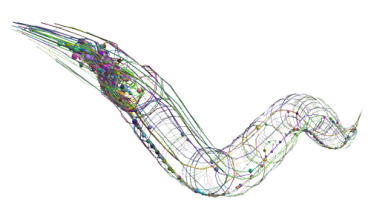The nematode Caenorhabditis elegans (C. elegans) has proven itself time and time again to be an organism of immense value to biomedical researchers. Important studies employing the biological model appear on a regular basis in top tier journals across a wide array of research areas. One perusing the scientific literature is reminded of the worm’s immense power quite regularly. Consider, for example, two related papers that appeared recently in the press; one regarding selective autophagy and lifespan[1], and the other focused on caloric restriction and how its anti-aging effects are elicited from a cellular/metabolic perspective[2].

In the former, Kumsta and colleagues show that the (C. elegans) protein p62/SQST-1 (~p62) plays an important role in recognizing cellular proteins, macromolecular structures, and even intracellular organelles – e.g., mitochondria, earmarked for destruction. Such recognition leads to trafficking of the p62-substrate to intracellular degradative centers where the actual destruction takes place. Importantly, worms genetically engineered to overexpress p62 enjoy not only an efficiently operating “selective autophagy” pathway, but also a 25% increase in lifespan. Which proteins precisely constitute the repertoire of those recognized by p62 remains to be determined, but the idea that selective autophagy is an extant mechanism in cells suggests myriad potential applications in targeting for destruction those proteins or structures identified as toxic, and associated with human disease. Cellular quality control is critical – and surveillance systems including those mediated by p62 that help maintain proteostasis (i.e., integrity of cell proteome) are essential.
The article by Weir and colleagues suggests that the anti-aging effects of caloric restriction are elicited, at least in part, through maintenance of mitochondrial network integrity, and an interplay with functional (i.e., fatty acid metabolizing) peroxisomes. AMP-activated protein kinase (AMPK) acts similarly to dietary restriction, eliciting many equivalent effects – including those on longevity. These studies beg the follow up question – are anti-aging therapeutics of the future those that both assure structurally sound mitochondria whose metabolic (read: fat metabolizing) functions are carefully coordinated with peroxisomes, and activate appropriate metabolic cascades – including those involving AMPK? The data generated with C. elegans and presented in this interesting (Cell Metabolism) paper certainly supports such conclusions.
A final word or two regarding C. elegans. Dr. Sydney Brenner performed pioneering work in the 1960s and 1970s establishing the organism as a powerful model for biomedical studies. Among the work done was a description of the worm’s neuronal circuitry. For these and related studies, Dr. Brenner, and Drs. H. Robert Horvitz and John Sulston were awarded the 2002 Nobel Prize in Physiology and Medicine. C. elegans was the first multicellular eukaryote to have its genome sequenced; the developmental outcome of every one of its 959 of its cells is known; and all its neural connections are identified. The latter, known as a “connectome”, is available in no other animal at present. The worm has been used in studies involving myriad topics in cell biology, with results impacting all aspects of human health, disease, and aging.
The organism made big news when it was revealed in 2003 that nematodes brought aboard the shuttle Columbia for experimental purposes, had survived the tragic fiery crash of the spacecraft. Upon reentry into the earth’s atmosphere, the creatures were exposed to astonishingly harsh temperatures, centrifugal/gravitational forces, and atmospheric conditions; yet they returned alive. If worms could survive such conditions – could other microorganisms also do so? Over the course of time, have microorganisms hitched rides on asteroids, comets, meteors and the like and traveled across the heavens – transferring life forms? Hmm…
SRT – January 2020
References:
[1] Kumsta C, Chang JT, Lee R, et al. The autophagy receptor p62/SQST-1 promotes proteostasis and longevity in C. elegans by inducing autophagy. Nat Commun. 2019;10(1):5648. Published 2019 Dec 11. doi:10.1038/s41467-019-13540-4
[2] Weir HJ, Yao P, Huynh FK, et al. Dietary Restriction and AMPK Increase Lifespan via Mitochondrial Network and Peroxisome Remodeling. Cell Metab. 2017;26(6):884–896.e5. doi:10.1016/j.cmet.2017.09.024
